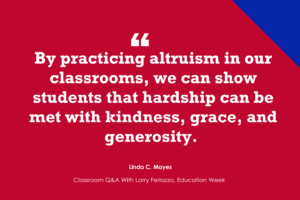
A Framework for Organizing Student Success Efforts (opinion)
From declining enrollments to equity gaps and growing concerns about student belonging, the pressures on colleges and universities—especially those serving first-generation and regional student populations—are intense and unrelenting. We have all read about the enrollment cliffs and seen firsthand how small, regional institutions are being asked to do more with less while still delivering transformational experiences to diverse and increasingly nontraditional learners.
While there is no single solution to these complex and multifaceted challenges, I believe we can and must do better to organize and focus our collective efforts. In my two decades of experience as a mathematics education professor, interim dean, student success leader and first-generation college graduate, I have repeatedly seen the power of synthesizing widely known but often disconnected strategies into coherent, institutionwide models for student success.
That experience led me to develop the ACCESS framework, a holistic and memorable approach that integrates six core pillars essential to supporting students from recruitment through graduation and beyond. These pillars—affinity, community, career, early alert, support and storytelling—are not novel in isolation. However, woven together, they offer a powerful and practical road map for institutions striving to create environments where students not only persist but thrive. Importantly, ACCESS also addresses what I see as a common and costly issue in higher education: fragmentation. Too often, well-intentioned programs exist in silos, failing to produce the sustained, cross-campus impact we seek. ACCESS offers a way to unify these efforts into a clear, student-centered strategy.
Affinity: Fostering Belonging From Day One
Students are more likely to succeed when they feel they belong. This is especially true for first-generation students, underrepresented populations and those navigating higher education in rural or regional settings where campus may feel unfamiliar or disconnected from prior experiences.
Affinity strategies focus on helping students quickly form meaningful connections with peers, faculty and the institution itself. Examples include first-year experience programs, peer mentorship initiatives, themed housing and proactive advising. Institutions that intentionally create these touch points early and often can increase students’ sense of belonging and purpose, which research has shown to be critical predictors of retention and achievement.
Affinity is about more than social engagement—it is about students seeing themselves as valued and capable members of the campus community.
Community: Building Meaningful and Reciprocal Connections
Beyond personal belonging, students benefit from opportunities to engage in shared purpose.
Community-focused strategies emphasize service learning, civic engagement, student organizations and collaborative learning experiences that help students feel connected not only to campus but to broader societal goals. Partnerships with local community and nonprofit organizations create reciprocal value: Students gain real-world experience and social capital while institutions strengthen ties with the communities they serve.
Moreover, community-building activities enhance peer support networks. Students engaged in study groups, cohort models or co-curricular leadership roles often demonstrate higher retention and graduation rates. Creating purposeful, inclusive spaces for students to connect with one another should be viewed as essential, not optional.
Career: Connecting Learning to Life After College
Students increasingly expect—and deserve—a clear connection between their academic experience and future opportunities. Career-connected learning, designed to deepen students’ classroom experiences by connecting skills to real-world occupations, has been shown to increase engagement, motivation, broader sense of purpose and sense of preparedness for employment. But career integration must go far beyond the traditional career center model. It should be infused throughout the student journey.
ACCESS emphasizes career as a core pillar, with a focus on early and ongoing exposure to career pathways, industry partnerships and hands-on learning. Microcredentials, internships, alumni mentoring and project-based courses all help students articulate the value of their degree and build the confidence to pursue their aspirations. When students can see the relevance of their studies to their goals, their motivation, persistence and sense of belonging increase substantially.
Early Alert: Leveraging Data to Intervene and Support
While many institutions have adopted early-alert systems, ACCESS emphasizes the importance of using data in intentional, coordinated ways across campus. A study of more than 16,000 students at a regional university found an early-alert system was effective at identifying students at significantly higher risk of dropping out, even when controlling for academic performance and demographic characteristics. Early-alert systems are not simply about identifying struggling students—they are about creating a culture where faculty, advisers and staff collaborate to proactively support students before issues become crises. Effective systems involve mobilizing cross-campus teams to conduct outreach—through emails, phone calls or in-person check-ins—to improve retention rates and remove barriers ranging from financial hardship to emotional stress.
Early alert requires more than technology. It requires buy-in, training and shared ownership. When done well, it sends a powerful message to students: “You matter, and we are here to help you succeed.”
Support: Providing Comprehensive, Seamless Services
Students’ lives are complex, and so are the challenges they face. ACCESS recognizes that academic success cannot be separated from wellness, financial stability and mental health. Institutions must offer robust, coordinated support systems that meet students where they are and that encompass everything from advising, tutoring and accessibility services to counseling, financial aid navigation and basic needs support. Centralized student success centers, coordinated case management models and wraparound services are all effective ways to ensure that no student falls through the cracks.
Wraparound student support services, especially when delivered through relational, trauma-informed and personalized case management, foster deeper connection and institutional engagement. This in turn supports retention and persistence outcomes. Importantly, support must be framed as a strength, not a deficiency. Normalizing help-seeking behavior and reducing stigma are essential to creating an environment where students feel safe accessing the resources they need.
Storytelling: Creating a Culture of Pride and Narrative
Finally, ACCESS includes a pillar that is often overlooked but profoundly impactful: storytelling. Students are more likely to persist and complete their degrees when they can see themselves as protagonists in their own educational journeys.
Institutions should prioritize sharing student and alumni stories—through social media, newsletters, admissions materials and campus events—to reinforce the value and relevance of the college experience. Equally important is empowering students to reflect on and tell their own stories, helping them make meaning of their experiences and building a sense of pride and ownership. Research suggests that as students reshape their narrative identities, seeing themselves not as outsiders but as capable contributors, they become more engaged and persistent in their academic work.
In my leadership roles, I have seen how storytelling humanizes data and drives institutional momentum. Donors connect emotionally to stories of transformation. Prospective students see possibilities reflected in the experiences of peers. Faculty and staff are reminded of their purpose. Storytelling, when done authentically, becomes a unifying force.
Putting ACCESS Into Action
The ACCESS framework is not prescriptive or rigid. Rather, it is an adaptable model that provides institutions with a common language and conceptual map for aligning efforts across recruitment, retention, student support and advancement.
I am mindful that the individual strategies embedded in ACCESS are not new. What is new—and, I believe, urgently needed—is a simple, memorable framework that helps institutions avoid fragmented initiatives and instead build integrated, student-centered ecosystems.
Importantly, ACCESS should not exist outside of the academic mission. Its greatest potential lies in integration with the curriculum. Faculty play a vital role in fostering belonging, connecting coursework to careers, identifying students in need of support and empowering students to reflect on their learning. When academic and co-curricular strategies align, student success becomes not a separate initiative but a seamless and transformative part of the college experience.
ACCESS can serve as a guide for cabinet-level planning, cross-departmental working groups, strategic enrollment management and assessment. It offers a way to bring together academic affairs, student affairs, advancement and community partners around a shared vision for student success.
As higher education faces unprecedented challenges, we must embrace models that are not only evidence-based but also intuitive and human-centered. I invite my colleagues across higher education to consider how ACCESS—or similar integrative models—might provide clarity, cohesion and inspiration as we work collectively to support the students we serve.
Source link


